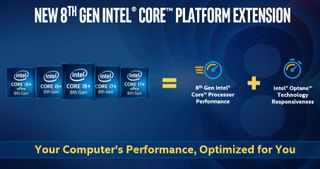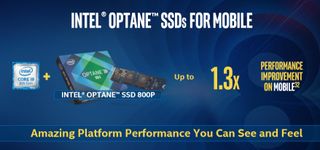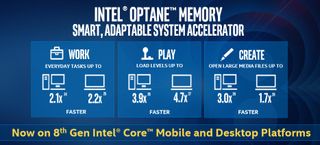New Intel RST Driver Increases Optane Memory Capabilities

Intel's new 300-Series chipset launch comes with a welcome addition designed to dramatically increase your system's responsiveness. The new Rapid Storage Technology (RST) 16.0.2 driver removes the exclusive primary boot volume limit for Optane cache technology with Optane Memory.
Now users will be able to accelerate a secondary storage volume with Intel's Optane Memory, Optane SSD 800P, and Optane SSD 900P products. That should broaden the appeal to the enthusiast crowd because Optane caching delivers a small benefit for caching SSDs, but explosive performance gains for HDDs. Many enthusiasts use a small SSD for their operating system and a larger hard drive to house large Steam libraries. That makes Optane caching especially appealing for the secondary HDD volume because it will boost game load times and responsiveness with frequently-accessed files.
The driver is not exclusive to the new 300-Series chipset products announced today. It's also backwards compatible with older chipsets but only adds the new Optane-specific features to 200-Series chipsets. Users of 100-Series chipsets are still locked out from using Optane Memory technology, officially, but you can still run the physical drives as cache SSDs with older Smart Response Technology (SRT) cache as long as the system will remap the PCIe lanes through the chipset.
Intel tells us the new RST 16.0.2 WHQL driver will show up online shortly. You should be able to find it on the RST download page on Intel's website.

The new Intel Core+ branded processors bring Optane Memory cache technology to mobile users, as well. A handful of companies announced notebook products at Computex last June with Optane Memory as a feature to cache the system drive. Many of those products failed to materialize as retail products. Intel's new "Plus" branding is a "simplified" way to say a new system ships with Intel's 8th generation Core processor and Optane technology.

A small plus sign is as insightful as the word "Optane" to most shoppers. Hopefully we don't have to relive the Optane Memory product name thing again while trying to talk about Optane 3D XPoint memory.

If you're not up to speed on the benefits of the high-speed memory technology used as non-volatile storage, we have three product reviews that fill the good, better, best verticals.
Stay on the Cutting Edge
Join the experts who read Tom's Hardware for the inside track on enthusiast PC tech news — and have for over 25 years. We'll send breaking news and in-depth reviews of CPUs, GPUs, AI, maker hardware and more straight to your inbox.
The technology works as advertised and notably increases system performance by opening windows and applications faster than a hard disk drive. The effect is less noticeable for users coming from flash-based storage, though.
Most Popular




